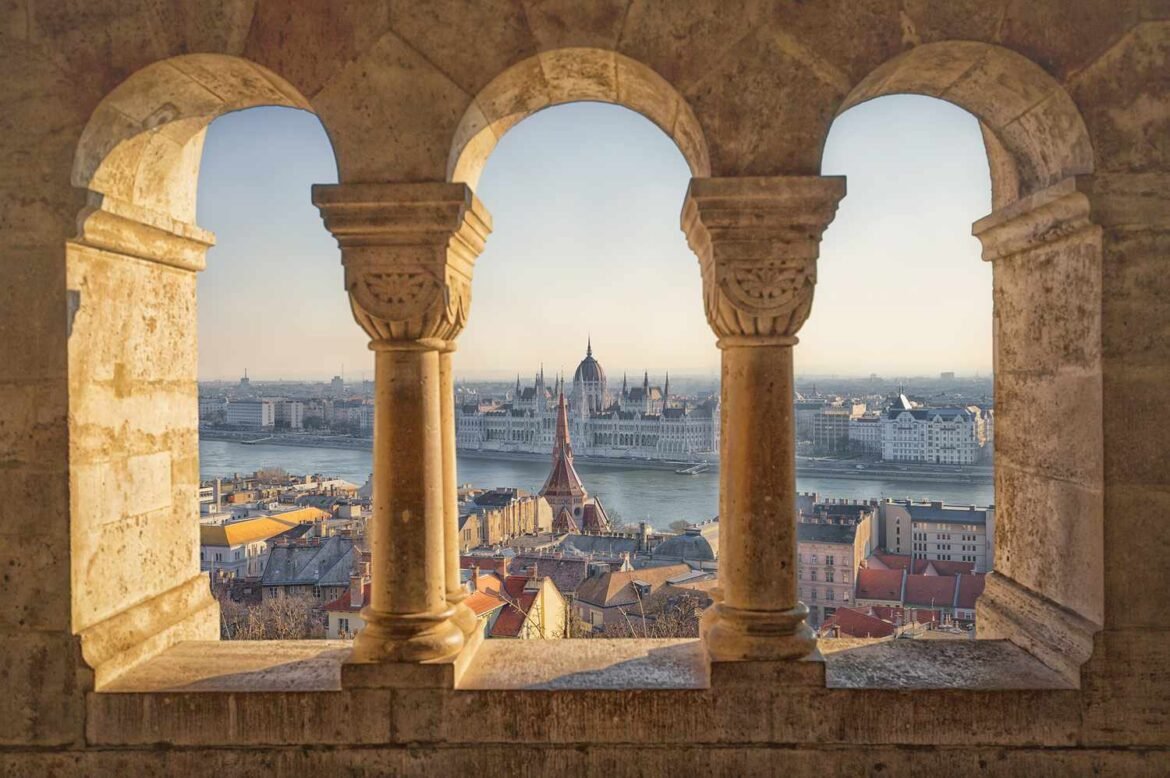:max_bytes(150000):strip_icc():format(jpeg)/TAL-header-2-budapest-castle-district-HUCAKEOFYEAR0425-54abb28754f044a097fce4eedc4ca552.jpg)
As a soft evening rain began to coat the cobblestone streets of Budapest’s Buda Castle District, my husband and I ducked excitedly into Korona Kávéház, a family-run confectionery and cafe, with dessert on the mind. The sweet we were after had been carefully considered and selected for me long before we set foot in the Pearl of the Danube. We came for a slice of Hungary’s 2024 Cake of the Year.
Sable Massingill Martinez/Travel + Leisure
Beaming with pride, our server brought to the table a towering piece of Mákvirág (Poppy Flower) cake. Created by Alfréd Kovács, owner and pastry chef of the Édes Vonal confectionery in Vác, the cake is sweet yet delicately tart and fruit-forward. It consists of alternating layers of spongy almond-flour poppy seed, crunchy black sesame, and black currant, and it’s topped with dense white chocolate icing. We would have voted for it twice.
Courtesy of The Hungarian Confectioners Association
Kovács shared what an honor this achievement was, especially considering his pastry shop had opened only five months prior to winning the competition. “The immediate surge in demand after winning was overwhelming. We worked day and night to serve all of our customers, but it was worth it,” the chef told Travel + Leisure. “This competition was a great opportunity to revive and refresh old, traditional flavors. My cake is not too sweet or overly heavy, as poppy seed cakes in Hungarian cuisine can be.”
The nation’s reverence for cake is deeply ingrained in its history and culture, with classics like Esterházy torte, characterized by its intricate spider-web icing, and the six-layer, chocolate cream-filled Stefánia cake, named after a princess, dating back to the Austro-Hungarian Empire.
Established in 2007, Hungary’s Cake of the Year competition is overseen by the Hungarian Confectioners’ Association, with the winner announced every year on St. Stephen’s Day. On Aug. 20, the national holiday, also known as Foundation Day, commemorates the foundation of the Hungarian state, and the Cake of the Year is considered a birthday cake for the country.
Sable Massingill Martinez/Travel + Leisure
“Over the years, Hungary’s cake has become an integral part of the Aug. 20th celebrations,” said László Selmeczi, the managing director of the association. “The winning cake is unveiled each year at a press conference held in the Hunter’s Hall of the Hungarian Parliament as part of the official state celebrations.”
One of these celebrations includes the Street of Hungarian Flavors, which honors Hungary’s proud cultural history of gastronomy. During the event, 30,000 to 40,000 slices of the newly crowned Cake of the Year are sold over the course of two days. Leading up to the national holiday, many pastry shops also prepare cakes from previous year’s competitions.
When asked about some of his favorite and most memorable cakes over the years, Selmeczi shared the 2016 Cake of the Year—Őrség Zöld Aranya (Green Gold of Őrség)—has remained popular, and is still widely available in most pastry shops. “It’s also my personal favorite because of its use of pumpkin seed oil in the sponge cake and the glazing, which pairs beautifully with raspberries and white chocolate.”
The competition offers pastry chefs the opportunity to further the heritage of Hungarian desserts, while contributing their own creations to that illustrious history. A new school of chefs like Kovács is committed to reinventing the classics of Hungarian pastry past, taking a more health-conscious, experimental approach. There’s even a sugar-free division from which a separate winner is selected. In 2024, that winner was Zöld Málna (Green Raspberry), a fruity, floral beauty made with pistachio, raspberry jelly, and rosewater, and decorated with dried rose petals.
Regardless of your taste preferences, Hungary’s storied pastry- and cake-making tradition has a bright future. Chefs entering the 2025 competition will celebrate the 140th anniversary of Hungary’s famed Dobos—a layered, sponge cake with chocolate buttercream and a caramel topping—that has been a staple of Hungarian desserts since József C. Dobos introduced it at the Budapest National General Exhibition in 1885. This year’s competition requires chefs to use the key ingredients characteristic of the cake, along with other suggested ingredients such as spices, native fruits, pálinka (a traditional Hungarian fruit brandy), or wines made from grape varieties indigenous to the Carpathian Basin.
Bookmark Aug. 20, 2025 on your calendar and prepare to celebrate one of the world’s sweetest traditions.


